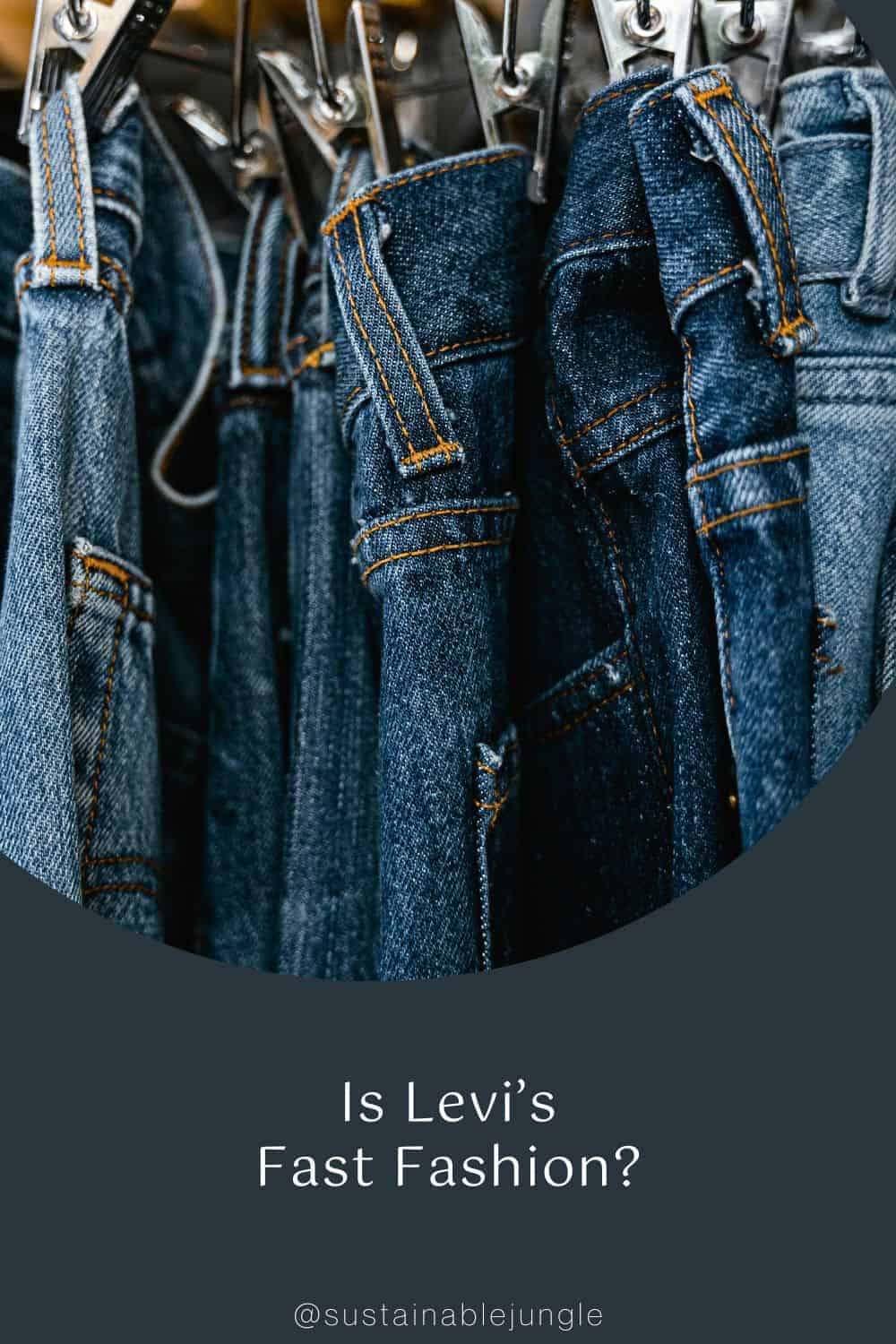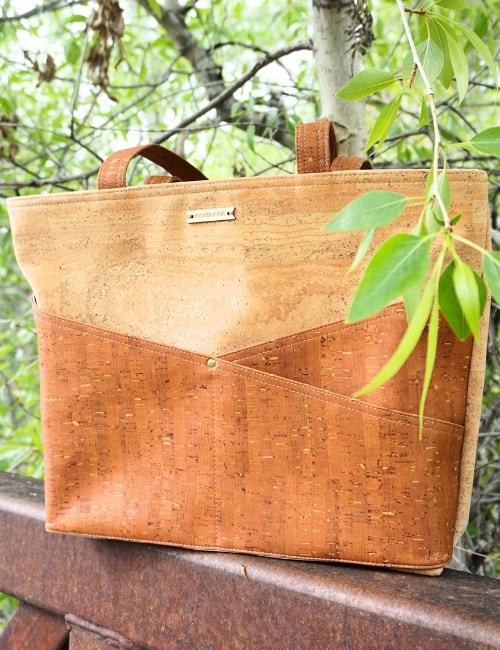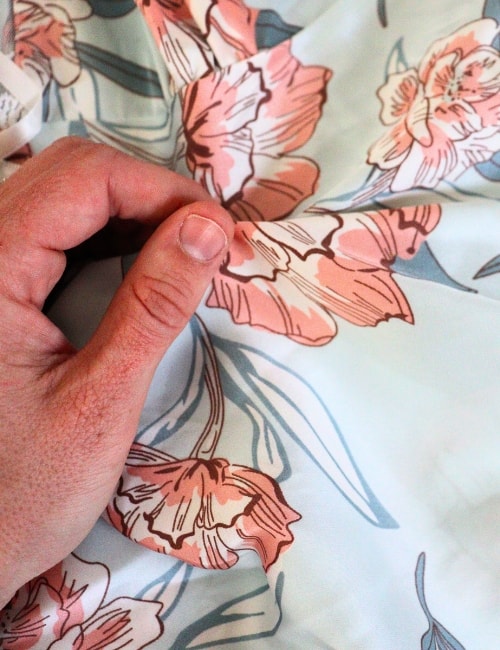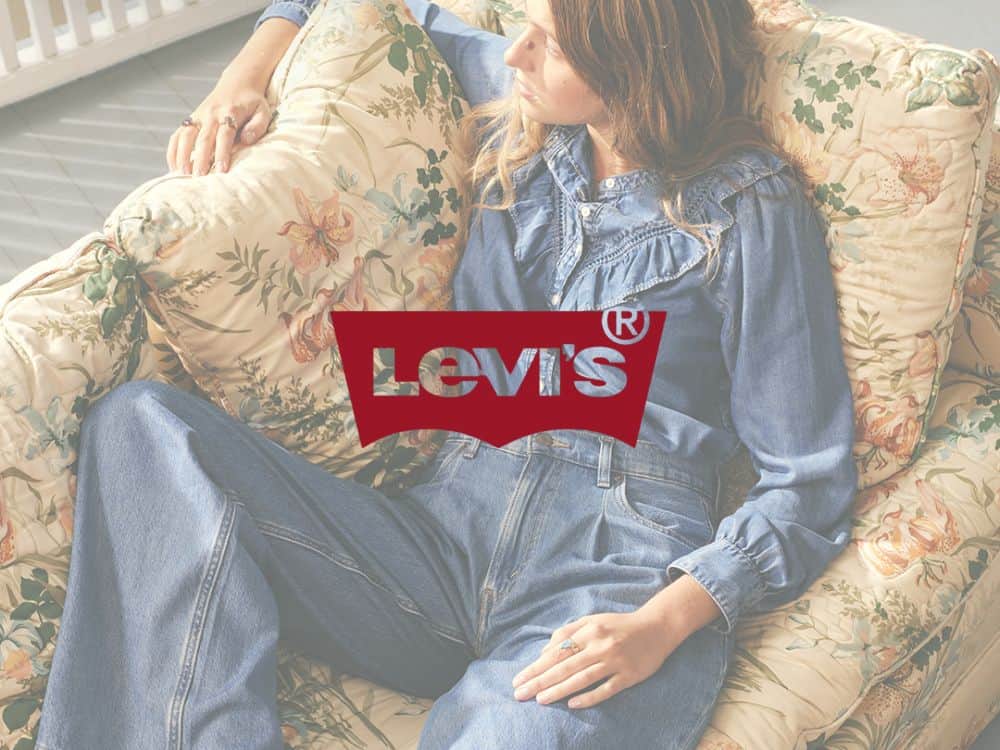
Is Levi’s Fast Fashion?
What brand is synonymous with blue jeans, cowboys, and punk rockers?
Old Navy is a good guess but it has to inescapably be Levi’s.
The company has been around for over 150 years and has undoubtedly one of the most prominent brand identities, stretching across 110 countries.
With such a long history and market share, you have to wonder, is Levi’s fast fashion?
The answer might surprise you. So, tighten your belt strap as we reveal the secrets behind Levi’s past, supply chain, and sustainability principles.
1. Uncovering: Is Levi’s A Fast Fashion Brand?

Levi Strauss & Co. is one of the oldest brands in the United States.
The company was created in May 1853 when German-Jewish immigrant Levi Strauss traveled to San Francisco to open a dry goods company.
After partnering with tailor Jacob Davis, the team combined copper rivets with denim to create the first pair of blue jeans in 1873.
Levi’s exploded in popularity between the 1950s and 1980s, as the casual blue jean style took over countless subcultures, like greasers, rockers, and hippies.
Today, Levi’s Signature Jeans turned over $6.18 billion in revenue in 2023 alone.
Given the iconic brand’s position in the global market, one has to wonder: Is Levi’s a sustainable brand and is Levi’s ethical?
2. Levi’s Controversies
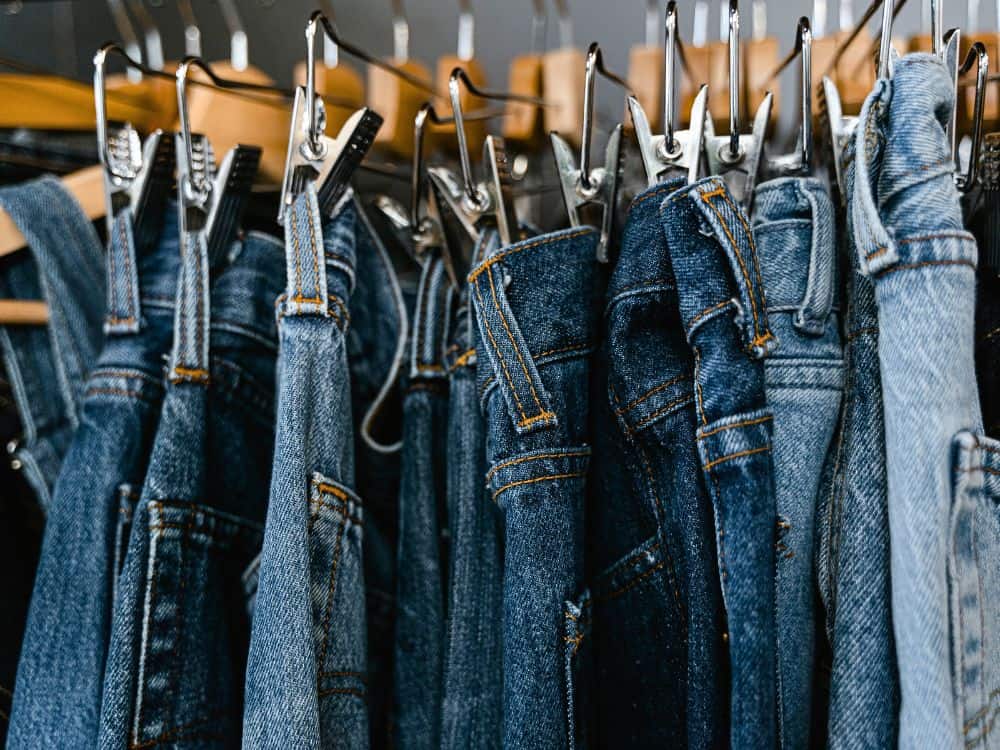
Any brand lasting over 150 years will surely have found itself in the hot seat. This is expected—acceptable practices change, and mistakes are made.
But is there a significant Levi’s controversy that marks how far the brand has come or how much they need to work on?
AI Models
Levi’s most recent controversy surrounds AI-generated models.
According to their press release, the brand has partnered with Lalaland.ai, a digital fashion studio that develops custom AI models. These models are hyperrealistic, showcasing every body size, shape, age, and skin tone you can imagine.
Levi’s claims this is to increase model diversity and provide a supplemental option for real models.
However, this press release faced significant backlash. Many are worried about what this could mean for real models, especially those from marginalized groups.
Others criticize Levi’s for using AI models to cut costs and are concerned about regulations regarding AI-generated advertisements.
Vintage Jeans Reflect Anti-Chinese Sentiment
With a history as long as Levi’s, you will surely encounter discrimination.
In 2022, a pair of Levi’s jeans were found in an abandoned mine shaft. The pair was from the 1880s and sold for $87,400 at a New Mexico auction.
Unfortunately, the vintage pair of jeans had the phrase “The only kind made by white labor” inscribed on one of the pockets.
These jeans come from a period after the United States Congress passed the Chinese Exclusion Act, which led to social pressure not to hire Chinese workers. Levi’s later reversed its policy in the 1890s, but this still marks a poignant moment in history.
Labor Protests
In 1990, Levi Strauss closed a manufacturing plant in San Antonio, Texas, where over 1,000 seamstresses saw their jobs exported to Costa Rica.
Some of these women worked for the company for multiple decades. They decided to form the activist group Fuerza Unida and picketed the company’s headquarters in San Francisco.
Fuerza Unida arranged hunger strikes and sit-ins to protest the company’s labor practices.
Sexual Harassment & Coercion In Lesotho Factories
In 2019, the Guardian reported on Worker Rights Consortium (WRC) allegations of sexual harassment and coercion at five factories owned by the Taiwanese company Nien Hsing.
The WRC investigation found that no disciplinary action had been taken and that workers were prevented from forming a union.
Levi’s, one of several brands involved, was quick to respond, requiring immediate changes in staffing and management. They also signed official agreements with women’s rights and labor groups that included forming an independent oversight body.
Refusal To Sign The International Accord
More recently, Levi’s has been criticized for failing to sign the International Accord to protect garment workers in Bangladesh and Pakistan.
Initially developed in response to the Rana Plaza tragedy, the International Accord for Health and Safety in the Textile and Garment Industry is a legally binding agreement between major clothing brands and global trade unions to ensure factory health and safety.
Despite protests calling upon Levi’s to join other brand signatories, they’ve held out, referring to their existing policies and practices as sufficient. Remake is still holding them accountable.
3. Levi’s Ethical Issues & Practices

With its fair share of controversies, you have to wonder, is Levi’s an ethical company?
Although the brand has had its ups and downs, they have done a reasonably good job setting industry standards.
Levi Strauss & Co. scored an overall rating of 60% in the 2023 Fashion Transparency Index. This isn’t the best score, but it’s well above the average of 26%.
Let’s dig deeper and answer the question: Is Levi’s ethical? And if so, how ethical is Levi’s?
Does Levi’s Use Sweatshops?
Does Levi’s use sweatshops to manufacture their jeans?
Not exactly.
In 1991, Levi’s was involved in a scandal involving their manufacturing partner, Tan Holdings Corporation, in the Northern Mariana Islands.
Along with several other big brand names, Levi’s garments were made by Chinese laborers under what the United States Department of Labor called “slave-like” conditions.
These conditions included less-than-minimum wages, seven-day working schedules, unsafe living and working environments, and other unethical practices. Levi’s partner, Tan Holdings Corporation, was ordered to pay $9 million back to workers.
Levi claimed they didn’t know of the conditions and ended their partnership shortly after, increasing labor initiatives and inspection methods, respectively.
What does Levi’s social responsibility look like today?
Let’s take a look.
Traceability & Working Conditions
First, where are Levi’s jeans made?
Most of their jeans are made overseas in countries like Bangladesh, China, Vietnam, and Indonesia.
According to the Fashion Revolutions 2023 Fashion Transparency Index Report, Levi’s received a 76% regarding overall supply chain traceability.
On Fashion Checker, an online database documenting supply chain standards, Levi’s received the highest score for transparency. Unfortunately, they also received the lowest score for living wages paid.
Levi’s has recently begun using the Fair Labor Association’s (FLA’s) Fair Compensation Toolkit and its latest Sustainability Report states that the company “will do business only with supply partners that provide wages and benefits that comply with applicable law and match the prevailing local manufacturing or finishing industry practices.”
Worker Well-Being Initiative
Levi’s manufacturing and supply chain practices have always been a priority. They were among the first brands to introduce a comprehensive code of conduct nearly 30 years ago.
In 2011, Levi Strauss & Co. began a new Worker Well-Being Initiative program. This goes beyond labor compliance to support the “financial empowerment, health and family well-being” of employees.
Before implementing any new project, Levi’s suppliers survey employees first-hand to understand what support they need. Afterward, they partner with local and national non-profits to implement new initiatives.
As of 2020, LS&Co. has reached roughly 195,000 workers across 118 factories and hopes to reach all 300,000 employees by 2025.
Supporting Racial Diversity, Immigration, & LGBTQ
Levi’s has been transparent about the company’s lack of racial diversity in leadership positions and has outlined its plans to address this.
The brand has a positive reputation for supporting progressive causes and was one of the earliest private sector companies to empower LGBTQ movements.
In 2017, Levi’s donated $1 million to support immigration and LGBTQ rights and, over recent years, has contributed $37 million to social justice organizations.
Animal Welfare
LS&Co. has an extensive Animal Welfare Protocol, ensuring ethical practices whenever animal products are used.
They do not allow the use of animal products from any endangered species on the IUCN Red List.
Levi’s does not use wool from mulesed sheep and is working to make sure all virgin wool is Responsible Wool Standard (RWS) certified by 2025.
The company follows the Responsible Down Standard (RDS), with 100% of its down products meeting the standard. They also prioritize sourcing from Leather Working Group-certified suppliers.
In 2022, they assessed cattle welfare in their supply chain following the Royal Society for the Prevention of Cruelty to Animals (RSPCA) standard.
4. Levi’s Sustainability Initiatives
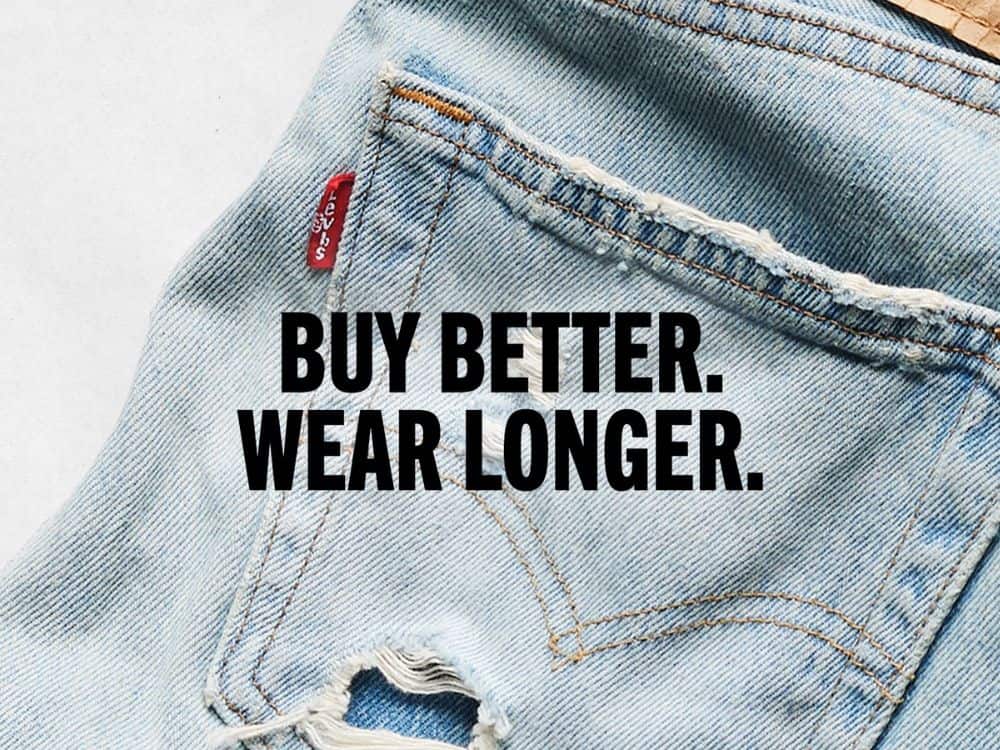
Sustainable Materials
Nearly 90% of the fibers used in Levi’s apparel are cotton-based, so it’s critical they use sustainable sources.
In 2021, 95% of their cotton was organic, recycled, or from Better Cotton Initiative (BCI) licensed farms—though as we’ve covered in the past, BCI Cotton itself faces a lot of criticism.
Their organic cotton is certified by Organic Content Standard (OCS) or Global Organic Textile Standard (GOTS), and in 2021, Levi’s joined the US Cotton Trust Protocol to help pioneer a new standard for sustainably grown cotton.
The brand intends to reach 100% certified or Textile Exchange Preferred sustainable cotton in 2025.
To achieve this, Levi’s plans to support organic agriculture, use more post-consumer recycled cotton, and incorporate pre-consumer recycled sources.
Levi’s sustainability report also details the use of the following sustainable fabrics:
- Cottonized Hemp
- Recycled Cotton
- Responsible Man-Made Cellulosic Fibers (Canopy Green Shirt-rated)
- Next-Generation Fibers (REFIBRA™)
- Recycled Synthetic Fibers (REPREVE®)
- RDS-certified down products
- RWS-certified ethical wool
With their goal to use “only third-party preferred or certified more sustainable primary materials by 2030”, a pair of “Levi’s sustainable jeans” may not be too much of a stretch.
Levi’s Water < Less Meaning & Impact
It takes roughly 1,800 thousand gallons of water to grow a pair of jeans worth of cotton, begging the question: “How is Levi’s sustainable?”
Levi’s introduced Water<Less® in 2011 to reduce its water usage. The system includes over 20 different techniques to reduce water—like tumbling jeans with bottle caps or golf balls instead of water.
As of 2020, Levi’s has saved almost 13 billion liters of water. Additionally, they allow other brands in the industry to use these techniques to increase overall water conservation.
Their comprehensive 2025 Water Action Strategy outlines their steps to meet their commitment of cutting water usage by 50% in areas of high water stress.
Chemical Usage
If you asked about Levi’s environmental sustainability ten years ago, you would receive a different answer.
Greenpeace called out Levi’s for dangerous water pollution practices in 2012.
Levi’s responded very well, pledging to minimize the hazardous chemicals used to dye and treat its jeans.
They set out to reach zero discharge of hazardous chemicals by 2020, a commitment they have fulfilled, and as an active member of the Zero Discharge of Hazardous Chemicals (ZDHC) Roadmap, continue to develop and expand chemical management procedures across their supply chain.
Climate Goals
Levi’s is working with the Science Based Targets initiative (SBTi) to develop climate goals with a commitment to reach net zero by 2050.
According to the brand’s 2022 sustainability report, they reduced their supply chain GHG emissions by 23% since 2016 and the emissions from all company-operated facilities by 71%.
Actions include conducting regular energy audits at their factories, switching to LED lighting, updating HVAC systems, and using renewable energy.
Circularity
Wondering what to do with old jeans?
The Levi’s® SecondHand e-commerce platform gives pre-loved jeans and jackets another life.
Keeping denim in circulation for longer means fewer garments going to landfill, less water usage, and less GHG emissions.
In 2021, they expanded to Europe, launching SecondChance in Germany. In the same year, Levi’s reclaimed over 19,000 garments through trade-ins.
You can also repair, update, or upcycle your denim with Levi’s Tailor Shops, available at 29 stores across North America.
If your old jeans are too damaged for resale, you can drop them off at a Levi’s store for recycling via their partner Blue Jeans Go Green™.
Towards Zero Waste
Levi’s has created several initiatives to address waste at all levels of its supply chain, including:
- Using print materials made from 100% post-consumer waste stock at Canadian and US retail locations.
- Implementing waste segregation and recycling programs at manufacturing facilities. One facility has collected over 400 metric tons of fabric scraps for recycling and recovery.
- Working to eliminate pumice stone waste across their apparel supply chain.
- Working to eliminate single-use plastics in consumer-facing packaging by 2030 by shifting to 100% reusable, recyclable, or home compostable plastics.
- Working to eliminate poly-bags across their supply chain and pre-packaging items to reduce waste.
These are just some of Levi’s sustainability campaigns. Full details regarding progress made towards the brand’s 16 sustainability goals can be found in their latest sustainability report.
Levi’s Sustainability Rating
Although there isn’t an official Levi’s sustainability rating, overall, we think the iconic brand is moving in the right direction.
The above sustainability endeavors have earned the brand a respectable score of 34 points in Remake’s 2022 Fashion Accountability Report. Levi Strauss & Co. also received an above-average score of 39 points in the latest Ethical Fashion Guide published by Baptist World Aid Australia.
However, it’s clear that they still have a long way to go before they can be called an eco-friendly clothing brand.
Did you know we Have a Newsletter?
We cover the latest in sustainable living, fashion, zero waste, beauty, travel, finance and more…
Final Thoughts On Is Levi’s Fast Fashion?
Is Levi’s considered fast fashion?
Not quite.
Fast fashion brands—like Shein and Zara—are known for their rapid production cycles, low prices, and trend-driven designs, often sacrificing quality and sustainability.
Levi’s does introduce new collections but doesn’t prioritize a quick turnover rate compared to other brands. Most of their fibers are organic or recycled and certified by third-party agencies.
Levi’s has also introduced several sustainability initiatives, like technologies to reduce water, packaging waste, and GHG emissions.
Is Levi’s an ethical brand?
Unfortunately, Levi’s still has its fair share of issues.
Although they follow the FLA’s Fair Compensation Toolkit, Levi’s (along with most other major brands) still rates incredibly poorly for paying their workers a living wage.
Remake has also questioned the efficacy of its worker health and safety programs, referencing issues highlighted by the brand’s own 2021 Sustainability Report as well as worker testimonies they have received.
No need to feel blue. You can still buy your 501’s pre-loved from one of the many second hand stores or check out other sustainable jeans for do-good denim.
Share this article with fellow jean-lovers and keep the conversation about ethical and sustainable fashion (rocking and) rolling.
Pin these:
